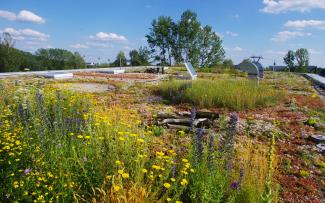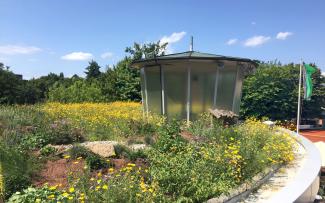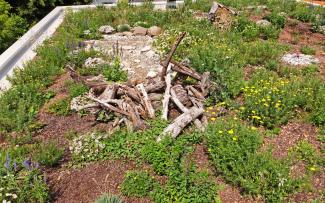Green Roofs to Preserve Biodiversity

A biodiversity roof installed on the IGA Visitor Centre in Berlin.

Biodiversity modules increase the variety of species on the roof, enabling insects and birds to find many forage crops and nesting places in stones, insect hotels and deadwood. © Hohenschlaeger

“Deadwood” should really be called “biotope wood”, as it is used as a habitat by moss, lichen, beetles and flies. © Hohenschlaeger
The conservation and recreation of biodiversity in nature, is one of the major objectives of a future-oriented, ecological and sustainable environmental policy. That’s why biodiverse green roofs nowadays become more frequently specified in urban planning as they are able to provide replacement habitats for flora and fauna which have been lost to building development and sealed ground. The Environment Act became law in Nov, 2021 and the new Biodiversity Net Gain Regulations should come into force during 2023 at the latest. Pure Sedum roofs are unlikely to deliver enough gain on their own and so this means that biodiverse green roofs will play an increasingly important role in landscaping.
Biodiverse roofs are low-maintenance extensive green roofs offering refuges for a great variety of animals and plant species. Birds, beetles, wild bees and butterflies find food and shelter there. However, the development of biodiversity largely depends on how the habitats provided on a roof are structured. To make an important contribution to preserving the biodiversity of flora and fauna they have to be appropriately designed and laid out. Pure sedum green roofs that are installed in conjunction with very shallow substrate depths are not suitable for exploiting this potential. Indeed, the biotope function of greened roof areas needs to be specifically fostered using various design features and applying basic biodiversity principles during planning and implementation.
The basic requirement of course is that the green roof has become permanently established and continues to thrive. This requires project-specific planning and a suitable and reliable Green roof system.
After that, a combination of several measures enhances the biotope function of the green roof:
The range of plant species, for example, can be extended by using various substrate depths. While a depth of 8 cm is sufficient for low-growing, low-maintenance sedum types and other succulents, the root area for biodiverse herb, grass and wildflower vegetation can be increased with individual landscape mounds to a depth of between 12 and 15 cm. When choosing the plants, particular attention can be paid to their significance as forage plants for insects and birds.
Dead branches and logs are particularly valuable structural elements for biodiverse roofs. They are used as a habitat by moss, lichens, fungi, beetles and flies. Vegetation-free spots with pebbles, boulders, gravels, and sands are an important enrichment, as they are used by insects and other roof inhabitants as a refuge, a breeding place and a sun trap. Additional nesting aids such as bug hotels serve to encourage the ongoing insect colonisation.
Finally, even temporary water areas can be included in order to improve the availability of water for insects and birds. In some places, sheeting is laid out and covered with sand in order to retain rainwater on the roof for a longer period of time.
By combining these measures a particularly biodiverse and ecologically invaluable habitat will develop. We should also remember that existing, species-poor extensive green roofs can be upgraded at any time, and in this way the diversity of flora and fauna will increase considerably. A solid basic knowledge of ecological relationships within natural habitats is always required when planning and designing biodiverse green roofs which are an exciting prospect for planners, architects, and landscapers alike.
For further information, please contact:
ZinCo Green Roof Systems Ltd.
F26, Elmfield House, New Yatt Road
Witney
OX28 1PB
Telephone: +44 1993 229700
e-mail: office@zinco-greenroof.co.uk